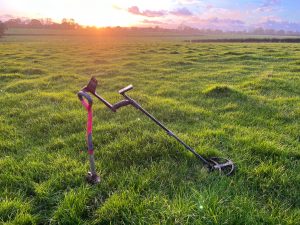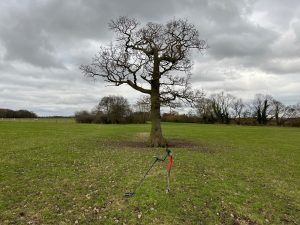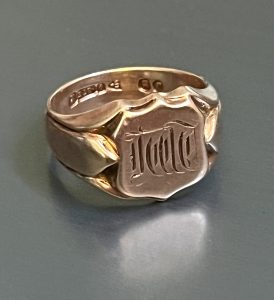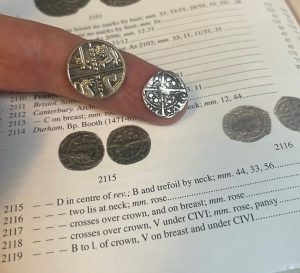
It was going to be a solo detecting excursion as sadly Bob couldn’t make it, it had been a busy week for him so was needing to catch up on his beauty sleep (he needs as much as possible to be fair!). I headed over to my current favourite permission and parked up in a layby alongside another field that given me quite a few amazing finds, but the grass was too long here and we had pretty much done this one to death, so it needed a bit of a rest anyway. Today it was going to be a new field on the opposite side of the busy road. It took a few minutes of waiting for a suitable gap in the traffic before I dashed across.
Although it was a new field, I had walked through it to get to the next field along, so had in reality maybe detected in there for no more than 5 minutes before today. I clambered over the gate and plunged my spade into the ground and switched on my trusty XP ORX and paired up the wireless headphones and extended the shaft to my preferred length. I switched on Tect-o-trak on my phone and set off. The idea today was just to gently roam and see what happened, so I just wandered off into the field, moving away from the din of heavy traffic speeding along the busy road.
I had set my ORX up with my current preferred settings and I was getting some signals but nothing that was tempting me to dig, so some low iron grunts and some higher ones that just didn’t sound like something that I would want to dig so I pressed on. Then I had a signal that was just that little better, it was a steady number on the display, the tone wasn’t perfect but it was something that was worth digging, so I pinpointed its location and dug down with my spade. The field was dairy pasture with medium length grass but it had been raining on and off for days now so the ground squelched as I eased a plug of turf out.
I checked the hole and whatever I had found was still in there, so it was time to get on my knees on the wet grass to use my hand held pinpointer. I quickly located where the find was, it was somewhere just below the base of the hole, so I used my digging tool to gently prise the muddy soil apart, lifting handfuls out and then checking with pinpointer again. After a few attempts my pinpointer told me that whatever it was, was now in the muddy lump that was in my hand. I kept squishing bits of the muddy off the main lump and eventually I could feel something, small thin and round, but it was so muddy that I couldn’t tell what it was. As much as I wiped it down it the mud just kept smearing across the surface. I didn’t have a waterspray bottle with me so I tried to spill some of my drink over it to clean it, I then caught just a glimpse of a silvery disc with a cross on it, before my muddy gloves smeared it again. I gave up with that idea and made my way to some muddy puddles at the edge of the field and washed it off in one.
I was then surprised and delighted to be holding in my hand a small hammered silver penny, it was battered and bruised, with some pieces around the edge missing but I didn’t care, I just love finding hammered coins and thinking about how long they had been buried in that field. Here it is just after being washed off in that muddy puddle.
I placed it inside my coinpod for closer inspection when I got home and continued to detect my way through the field. The next signals that I dug were all just random pieces of scrap lead, they could have been anything and of virtually any age, but random scraps of lead come with the territory when you are metal detecting.
Then came another one but at least this time it was identifiable as a small pistol shot or musket ball. I don’t mind finding musket balls as it show activity on the land probably dating back to the 1600’s, well that’s what I always thought to myself. That notion was pretty much knocked on the head a few months ago however when I found maybe a dozen of them on a small raised piece of land opposite an old stone wall. The lady landowner had wandered over for a chat and I was telling here how back in time someone had once stood at that wall firing at something on this raised piece of land. She said that I was correct because she had witnessed it herself. How old was this lady I thought, or was she some sort of time traveler? But no she said it was a friend of her son’s who had bought a replica working gun and they were firing it from the wall into the raised piece of land and the year this took place was 1995! So not all musket balls are necessarily very old.
So back in the muddy field I continued my way, I then hit a series of ‘moo tubes’as most detectorists call them. There is a type of pet treat that goes by the same name but in the world of metal detecting moo tubes are small metal tubes of medicinal ointment that a farmer applies to the teats of cows and sheep to deal with mastitis. Dairy farms are littered with them. They produce a great signal that is loud and vibrant and you almost always know what it is going to be but you have to dig it anyway… just in case.
My next decent find was a 1947 penny that was in reasonable condition, but pre decimal copper coins don’t really do it for me, but of course ‘a coin is a coin’. This was followed in fairly close succession by a few copper half pennies of a similar age and then a larger older copper coin that was virtually blank on either side but a close inspection just revealed the very faint remains of the design of a George III penny so probably from around 1800.
I then started tracking along the hedgeline maybe a metre or so off the hedge, nothing much other than scraps of waste metal were coming up but eventually another copper penny revealed itself. This was a Queen Victoria Penny dated 1862 and in reasonably good condition, but copper coins buried underground rarely survive well.

By now I was about four hours in and the rain was coming down almost sideways and I was wet and cold, and I was also starting to lose the light so I decided to make my way back to the gate and to get off home. On the way back I came across more lead, and more moo tubes, but I did get one more nice signal, which of course I dug. Again it was below the level of the plug that I had dug out but it didn’t take long for me to locate it with my pinpointer and it was amazing too catch a glimpse of silver in the mud. I wasn’t sure what it was at first. I could see the bust of a lady which was like Victoria but not quite. I wondered if it was a Victoria shilling from one of the colonies, anyway it went into my coinpod with the other finds, to be investigated further at home out of the rain.

I quickly packed up and climbed the fence before playing chicken with the Saturday rush hour cars and getting to my car and driving the 10 minutes that it took me to get home. My finds were cleaned and I posted the hammered coin on a Facebook group for identification. It is an Edward III London Mint Pre Treaty penny which accurately dates it to 1354-55, so that has been in that field for quite some time.
I figured out the other silver coin myself using my copy of Spinks. It is an 1887 Queen Victoria small jubilee head silver shilling. These were only minted from 1887-1889 because Queen Victoria felt that the small crown made her look silly so had the bust redesigned. So I’m quite happy with that as a find.
Here are the two silver coins after a gentle clean up.

Well that’s all for now, don’t forget to come back soon for more metal detecting stuff!
If you like my content and want to see more, why not subscribe using the subscribe option at the bottom of the page. It doesn’t cost you anything, it just means that I can email you to let you know when I publish a new post or article. Thanks




